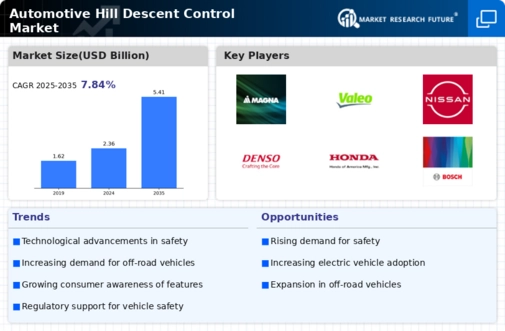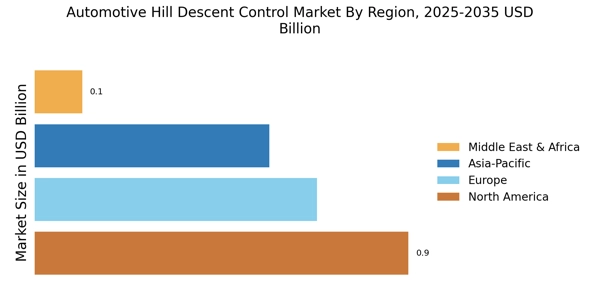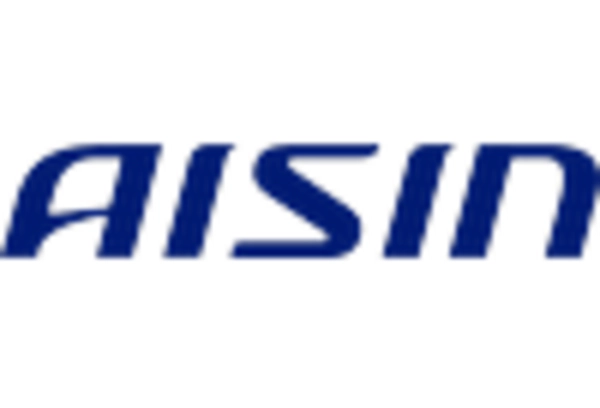Focus on Off-Road Capabilities
The increasing consumer interest in off-road vehicles is driving the Automotive Hill Descent Control Market. As outdoor recreational activities gain popularity, manufacturers are focusing on enhancing the off-road capabilities of their vehicles. Hill descent control systems are becoming essential features for off-road enthusiasts, providing better control and safety on steep descents. Market data indicates that the off-road vehicle segment is expected to witness a growth rate of approximately 8% annually. This trend suggests that automakers are likely to invest in advanced hill descent control technologies to meet consumer demands. The emphasis on off-road capabilities not only enhances the appeal of vehicles but also positions the Automotive Hill Descent Control Market as a critical component in the development of rugged, adventure-ready vehicles.
Regulatory Compliance and Safety Standards
Regulatory compliance and safety standards are becoming increasingly stringent, thereby impacting the Automotive Hill Descent Control Market. Governments worldwide are implementing regulations that mandate the inclusion of advanced safety features in vehicles. As a result, manufacturers are compelled to integrate hill descent control systems to meet these requirements. The push for enhanced safety measures is likely to drive the adoption of such technologies, as non-compliance could lead to significant penalties. Market analysis suggests that the automotive regulatory landscape is evolving, with a focus on reducing accidents and improving vehicle safety. Consequently, the Automotive Hill Descent Control Market may experience growth as manufacturers strive to comply with these regulations while enhancing their product offerings.
Technological Advancements in Automotive Safety
Technological advancements in automotive safety are significantly influencing the Automotive Hill Descent Control Market. Innovations such as improved sensor technologies and real-time data processing are enhancing the effectiveness of hill descent control systems. These advancements allow for more precise control of vehicle speed and stability on steep inclines. Recent studies indicate that the automotive safety market is expected to grow at a CAGR of around 9%, reflecting the increasing consumer demand for safer vehicles. As manufacturers prioritize safety features, the integration of advanced hill descent control systems is likely to become a standard offering. This trend not only boosts consumer confidence but also drives the overall growth of the Automotive Hill Descent Control Market, as safety remains a top priority for both manufacturers and consumers.
Consumer Awareness and Demand for Safety Features
Consumer awareness regarding vehicle safety features is a crucial driver for the Automotive Hill Descent Control Market. As consumers become more informed about the benefits of advanced safety technologies, their demand for vehicles equipped with hill descent control systems is likely to increase. Surveys indicate that a significant percentage of consumers prioritize safety features when purchasing vehicles, with many willing to pay a premium for enhanced safety. This growing awareness is prompting manufacturers to incorporate hill descent control as a standard feature in their offerings. The Automotive Hill Descent Control Market is expected to benefit from this trend, as automakers respond to consumer preferences by enhancing their safety technology portfolios.
Integration with Advanced Driver Assistance Systems
The integration of Automotive Hill Descent Control Market with advanced driver assistance systems (ADAS) is a pivotal driver of growth. As vehicles become increasingly equipped with sophisticated technologies, the demand for seamless integration of hill descent control features is rising. This integration enhances safety and driving comfort, particularly in challenging terrains. According to industry reports, the ADAS market is projected to grow significantly, with a compound annual growth rate (CAGR) of over 10% in the coming years. This growth is likely to propel the Automotive Hill Descent Control Market, as manufacturers seek to offer comprehensive safety solutions that include hill descent control as a standard feature. Consequently, the synergy between ADAS and hill descent control systems may lead to improved vehicle performance and consumer satisfaction.


















Leave a Comment